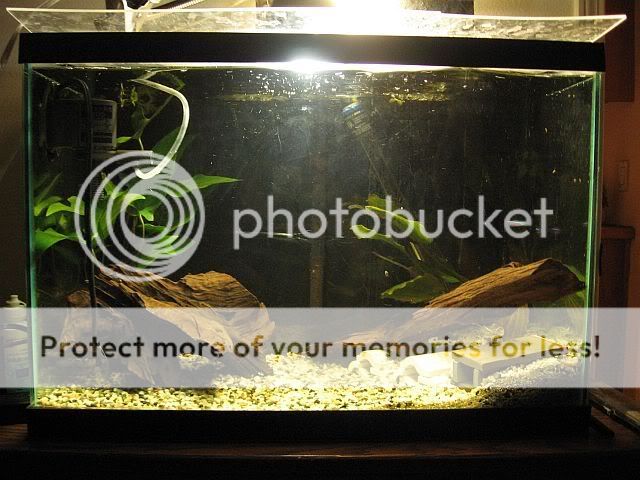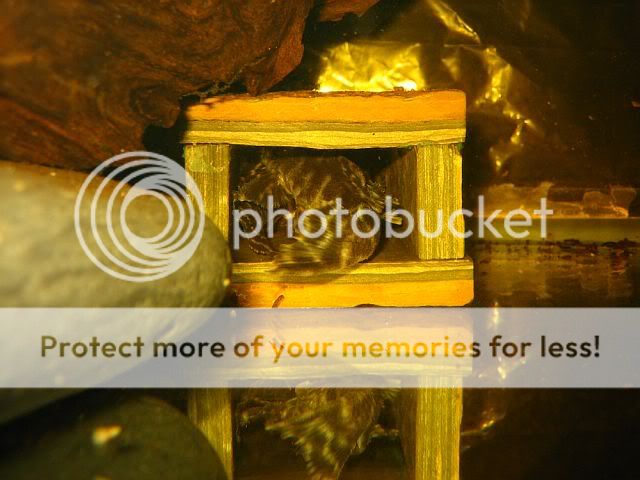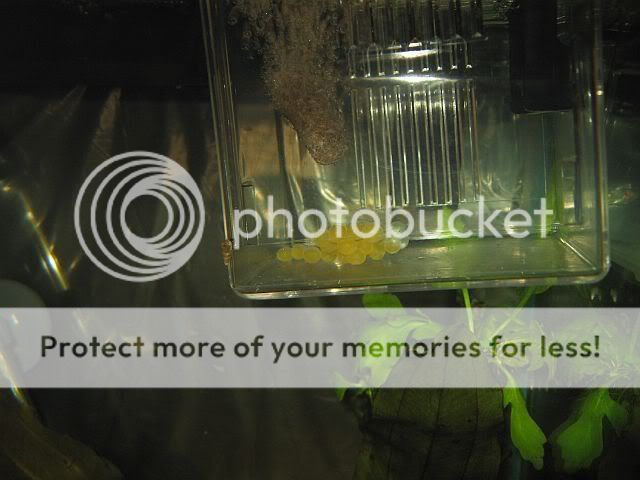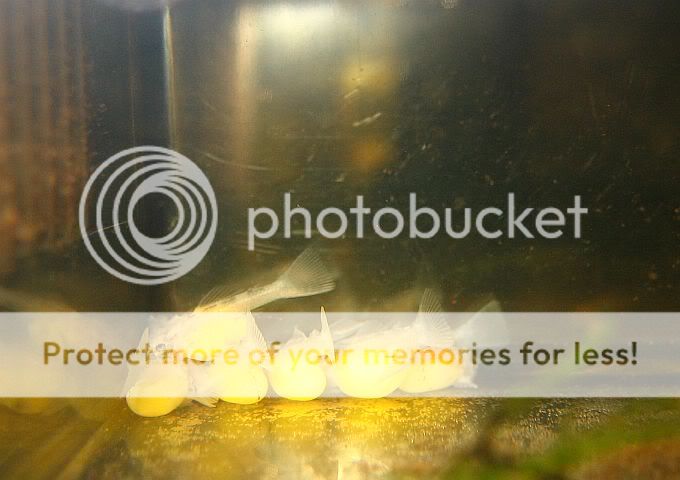All assigned numbers: L316
Name:
Location: South America: Rio Jari, Pará, Brazil.
Photos:








Appearance: Of all the hypancistrines, few look as bizzare relative to their congeners as this. The body shape and structure is deviates quite radically from other hypancistrus, with it's long broad head and thickset hindquarters. Males also tend to grow thick odontodes throughout the body, especially along the lower flanks, reminiscent of certain peckoltia, while the interopercular growths tend to be more reserved than that of other hypancistrine males of the L-66 group. The most prominent feature of these animals is their small eye to body ratio. With this in mind, no other hypancistrus comes close to L-316 in terms of eye miniaturization expect L-174, which has a completely different color scheme.**
More info and photo: Identification of Hypancistrus
Compatibility: When cramped for space and without enough hiding places, hostilities can break out, resulting in - sometimes severe - injuries. Despite that, the Rio Jari Zebra Pleco is best kept in a small group, as it will show more natural behaviour and is more comfortable in when accompanied by a number of others of its own kind.
Sexing and Breeding: Because of its small maximum size, a relatively small tank is sufficient for a (breeding) group: a tank width a surface area of 80x40cm. (32x16") is enough to house a (breeding) group of 5-6 individuals: the division of sexes is ideal with one male for every 2-3 females. To get these fish to breed, you need a heavily oxygenated tank with a number of spawning caves, a powerhead that runs water along the cave entrances, and a temperature that is raised to 82-86 degrees Fahrenheit (28-30 degrees Celsius).
Diet: An Omnivore that leans towards a meatier diet, so the main diet should consist of meaty foods: frozen foods (tubifex, mosquito larvae, blood worms, artemia), dry foods (freeze-dried foods, flakes, granules), carnivore sinking pellets, and occasionally some small pieces of shrimp, mussels or fish fillet are usually readily accepted. Once acclimatized, it will often also accept vegetable matter such as algae/spirulina disks and fresh vegetables (lettuce, zucchini/courgette, eggplant/aubergine, capsicum, carrot, peas, preboiled spinach).
This species usually does not eat algae (it lacks suitable teeth for that task), so it's not a suitable fish to keep your tank free of algae.
Water parameters: Temp 22-30c PH 5.5-7.5
This small Loricarid prefers a dimly lit tank with a good number of hiding places, either created with plants, drift wood, rocks or artificial (pleco spawning) caves. To keep more than one specimen in the same tank, or together with other bottom dwelling fish, you need at least a 40x16" (100x40cm.) tank: this fish can be quite territorial, and when suitable hiding places are lacking, it can be aggressive towards other bottom dwellers. When kept as only catfish in an aquarium, a tank size of 32x14" (80x35cm.) is sufficient, but it is recommended to keep this species in a group in a species tank.
The Rio Jari Zebra Pleco does best in warm, soft, slightly acidic to neutral water (pH 6.0-7,0), oxygen-rich water and a lot of currents. A powerful filter system is recommended, as this fish produces a lot of waste.
Max Size: 10-12cm. (4-5")
Bred by: cup, Jozebs, thegeeman
Breeding Log: See post below. For questions and comments please use original thread L316 Log
Additional Comments:
Hypancistrus youngsters may require a more vegetable based diet according to Back to Nature Lnumbers book.
This species looks very familiar to similar-colored and -patterned species from the genus Hypancistrus, such as L129, L199, L270 and L319. One of the few distinguishing features of L316 is the size of its eyes - whereas most Hypancistrus-pleco's have relatively large eyes, the Rio Jari Zebra Pleco has much smaller eyes.
Another features to look at is the absence or presence of coloration and/or a pattern on the belly-side. This species has the same coloration and pattern on the belly, whereas some other species have a white underside.
Profile information used with permission from www.piranha-Info.com
** Thank you to cup for permission to use the profile information from the Idenification of Hypancistrus article
Name:
Location: South America: Rio Jari, Pará, Brazil.
Photos:








Appearance: Of all the hypancistrines, few look as bizzare relative to their congeners as this. The body shape and structure is deviates quite radically from other hypancistrus, with it's long broad head and thickset hindquarters. Males also tend to grow thick odontodes throughout the body, especially along the lower flanks, reminiscent of certain peckoltia, while the interopercular growths tend to be more reserved than that of other hypancistrine males of the L-66 group. The most prominent feature of these animals is their small eye to body ratio. With this in mind, no other hypancistrus comes close to L-316 in terms of eye miniaturization expect L-174, which has a completely different color scheme.**
More info and photo: Identification of Hypancistrus
Compatibility: When cramped for space and without enough hiding places, hostilities can break out, resulting in - sometimes severe - injuries. Despite that, the Rio Jari Zebra Pleco is best kept in a small group, as it will show more natural behaviour and is more comfortable in when accompanied by a number of others of its own kind.
Sexing and Breeding: Because of its small maximum size, a relatively small tank is sufficient for a (breeding) group: a tank width a surface area of 80x40cm. (32x16") is enough to house a (breeding) group of 5-6 individuals: the division of sexes is ideal with one male for every 2-3 females. To get these fish to breed, you need a heavily oxygenated tank with a number of spawning caves, a powerhead that runs water along the cave entrances, and a temperature that is raised to 82-86 degrees Fahrenheit (28-30 degrees Celsius).
Diet: An Omnivore that leans towards a meatier diet, so the main diet should consist of meaty foods: frozen foods (tubifex, mosquito larvae, blood worms, artemia), dry foods (freeze-dried foods, flakes, granules), carnivore sinking pellets, and occasionally some small pieces of shrimp, mussels or fish fillet are usually readily accepted. Once acclimatized, it will often also accept vegetable matter such as algae/spirulina disks and fresh vegetables (lettuce, zucchini/courgette, eggplant/aubergine, capsicum, carrot, peas, preboiled spinach).
This species usually does not eat algae (it lacks suitable teeth for that task), so it's not a suitable fish to keep your tank free of algae.
Water parameters: Temp 22-30c PH 5.5-7.5
This small Loricarid prefers a dimly lit tank with a good number of hiding places, either created with plants, drift wood, rocks or artificial (pleco spawning) caves. To keep more than one specimen in the same tank, or together with other bottom dwelling fish, you need at least a 40x16" (100x40cm.) tank: this fish can be quite territorial, and when suitable hiding places are lacking, it can be aggressive towards other bottom dwellers. When kept as only catfish in an aquarium, a tank size of 32x14" (80x35cm.) is sufficient, but it is recommended to keep this species in a group in a species tank.
The Rio Jari Zebra Pleco does best in warm, soft, slightly acidic to neutral water (pH 6.0-7,0), oxygen-rich water and a lot of currents. A powerful filter system is recommended, as this fish produces a lot of waste.
Max Size: 10-12cm. (4-5")
Bred by: cup, Jozebs, thegeeman
Breeding Log: See post below. For questions and comments please use original thread L316 Log
Additional Comments:
Hypancistrus youngsters may require a more vegetable based diet according to Back to Nature Lnumbers book.
This species looks very familiar to similar-colored and -patterned species from the genus Hypancistrus, such as L129, L199, L270 and L319. One of the few distinguishing features of L316 is the size of its eyes - whereas most Hypancistrus-pleco's have relatively large eyes, the Rio Jari Zebra Pleco has much smaller eyes.
Another features to look at is the absence or presence of coloration and/or a pattern on the belly-side. This species has the same coloration and pattern on the belly, whereas some other species have a white underside.
Profile information used with permission from www.piranha-Info.com
** Thank you to cup for permission to use the profile information from the Idenification of Hypancistrus article





